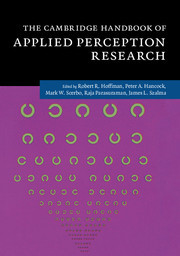Description
The Cambridge Handbook of Applied Perception Research 2 Hardback Volumes
Author: HOFFMAN Robert R.
Language: English
Approximative price 250.36 €
In Print (Delivery period: 14 days).
Add to cart
Publication date: 01-2015
Description
/li>Contents
/li>
The Cambridge Handbook of Applied Perception Research covers core areas of research in perception with an emphasis on its application to real-world environments. Topics include multisensory processing of information, time perception, sustained attention, and signal detection, as well as pedagogical issues surrounding the training of applied perception researchers. In addition to familiar topics, such as perceptual learning, the Handbook focuses on emerging areas of importance, such as human-robot coordination, haptic interfaces, and issues facing societies in the twenty-first century (such as terrorism and threat detection, medical errors, the broader implications of automation). Organized into sections representing major areas of theoretical and practical importance for the application of perception psychology to human performance and the design and operation of human-technology interdependence, it also addresses the challenges to basic research, including the problem of quantifying information, defining cognitive resources, and theoretical advances in the nature of attention and perceptual processes.
Part I. Background and Methodology: 1. Applied perception research: an introduction to this handbook; 2. Some highlights in the history of applied perception research; 3. Psychophysical methods and signal detection: recent advances in theory; 4. The measurement of perceptual resources and workload; 5. Methods and applications of eye tracking; 6. Applied perception and neuroergonomics; Part II. Attention and Perceptual Processes: 7. Perception and attention: a multidimensional approach to human performance modeling; 8. Attention as a cause and an effect of perception; 9. Probing plasticity of attention and working memory processes induced by video game play; 10. Visual attention and emotion: studying influence on a two-way street; 11. Perception and human information processing in visual search; 12. Motivation and emotion in sustained attention; 13. Vigilance: a perceptual challenge; 14. Psychology of time: basic and applied issues; Part III. Modality: 15. Multimodal and multisensory displays for perceptual tasks; 16. Multi-modal and cross-modal perception: audition; 17. Haptic perception; 18. Visual information in the coordination and control of isometric force; 19. Guidelines for vibrotactile display design: front-end, intensitive, and spatial considerations; 20. Olfactory interfaces; Part IV. Perception in Context: 21. Biological motion perception; 22. Perceptual segmentation of natural events: theory, methods, and applications; 23. Attention in the wild: visual attention in complex, dynamic, and social environments; 24. Perception of trust in automation; 25. Applied ecological acoustics; 26. Affordance perception research; 27. Perceiving the nesting of affordances for complex goal-directed actions; 28. Perception of collision; 29. Hazard awareness in driving: measurement and training; Part V. Perception and Design: 30. Applied perception and virtual environment training systems; 31. Using task analysis and computational cognitive models to design and evaluate interfaces; 32. Interface design: a control theoretic context for a triadic meaning processing approach; 33. Ecological interface design: a selective overview; 34. Perceptual learning in the comprehension of animation and animated diagrams; 35. Towards empirically verified cartographic displays; Part VI. Perception and Domains of Work and Professional Experience: 36. Perceptual learning and expertise; 37. Noticing events in the visual workplace: the SEEV and NSEEV models; 38. Sustained attention in operational settings; 39. Using simulation to examine perceptual challenges faced by healthcare providers; 40. Color vision in aviation; 41. Eye, robot: visual perception and human-robot interaction; 42. Human-robot interaction as extending human perception to new scales; 43. Applied perception in military applications: detection of hidden explosive hazards; 44. Situation awareness in command and control; 45. Spatial orientation and motion perception in microgravity; 46. Evaluating visually induced motion sickness; 47. Predicting the future in perceptual-motor domains: perceptual anticipation, option generation, and expertise; Part VII. Individual and Population Differences: 48. Sustained attention in infants and children; 49. Gender differences in time perception; 50. Early visual processing abnormalities related to schizophrenia and autistic spectrum disorders; 51. Considering older adults' perceptual capabilities in the design process; 52. Comparative applied perception research: the case of working dogs; Part VIII. Pedagogical and Professional Issues: 53. Pedagogical issues in teaching the psychology of perception; 54. Graduate training and experiences for careers in applied experimental psychology.
© 2024 LAVOISIER S.A.S.
These books may interest you

The Handbook of Speech Perception 182.42 €



